Empress TreePaulownia tomentosaHeight: 30' average mature height Hardiness Zones: 5-8 Find my zone Aspect: half shade to full sun
This plant can't be shipped to Connecticut, Maine
Size Availability
Out of season.
Our main crop of most plants is available starting in late fall.
Additional batches of plugs and quarts are usually added in May.
Many of our plants are propagated in limited quantities and can sell out quickly when posted, get on the notification list below so you don't miss out. Add your email to be notified as soon as we have them back in stock:
This does NOT subscribe your email to any mailing lists, our system will only send an inventory notification message.
A tough species that is tolerant growing in poor soils and drought conditions, the Empress Tree produces thousands of large pink flowers in the spring before the leaves start to emerge. Once the flowering season is done the leaves emerge and grow from one to two feet long and almost as wide, creating an instant tropical appearance. Trees can be grown in either a shrub form by pruning the tops back or in tree form by removing all but one trunk in the winter, without pruning Empress Trees will typically form a 2-3 trunk tree with wide branches. They are popular in parks where they provide shade for a large area and are popular as they are one of the most colorful large trees in the spring. You need a fair amount of space in your landscape for this species to reach its full potential but gardeners with smaller yards have been very successful pruning these into smaller forms. They bloom on old wood so heavy winter pruning can reduce flowering the next spring, with Empress Trees any heavy pruning should be done in early summer.
Very cold winters can reduce flowering the next spring, this is mostly an issue in zone 5 but can also affect growers in zone 6 when planting in very exposed locations. For growers in very cold climates flowering is greatly improved by planting in areas protected from strong winter winds.
Empress Trees prefer full sun in well drained soil, they are typically intolerant of heavy clay soils in flat landscapes. If you have heavy clay soils you can still grow this tree by planting on a mound of well drained soil, for large trees like this the mound should be 4-5 feet in diameter and at least two feet tall. An easy and cheap method for creating landscape mounds is to dump a few cubic yards of conifer bark (not wood chips) such as pine, fir, spruce, or hemlock. Till or mix the bark in with some of your native soil and pile the material into a mound, you can plant the tree directly in the center of the mound. Bark chips and shreds take a very long time to break down compared to wood chips and provide excellent drainage and soil aeration with the coarse fibers.
Shipping
Unlike most trees, Empress Trees tend to re-sprout from the base each year while young while the leader from the previous year dies back. Trees are shipped pruned back to around six inches tall, plant with the top of the roots covered by about one inch of soil. The following year a new stem will grow from the crown of the roots. Once the roots are established the existing trunk will persist and form a permanent tree. Even as trees grow into a permanent form the growing tip will end with a flower in the summer so trees will typically produce a wide branched form starting low to the ground. If you wish you can prune the side branches each summer to force a straight trunk.
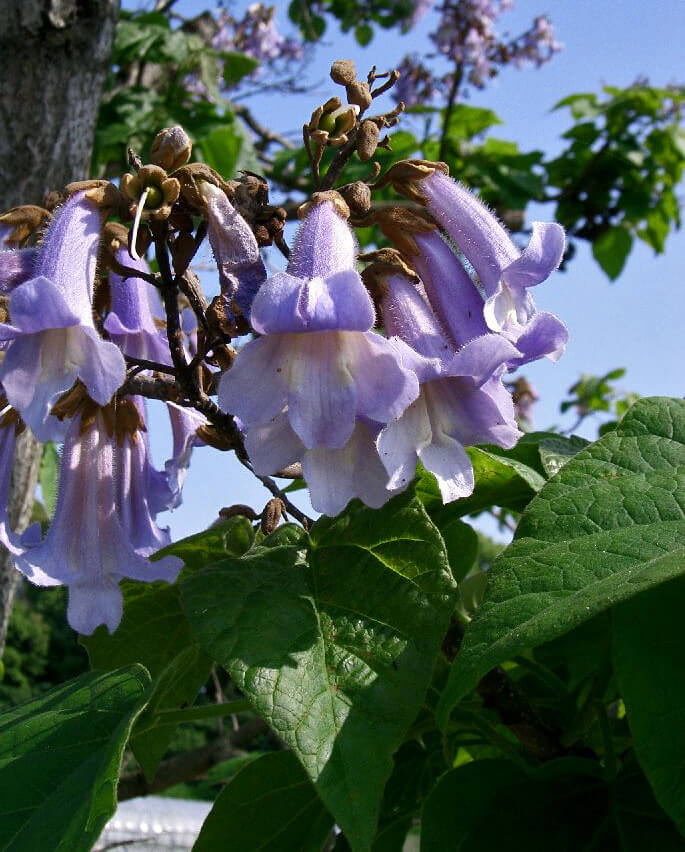 Close up of the flowers on an Empress Tree
Source: Commons
 Close up of the flowers on an Empress Tree
Source: Commons
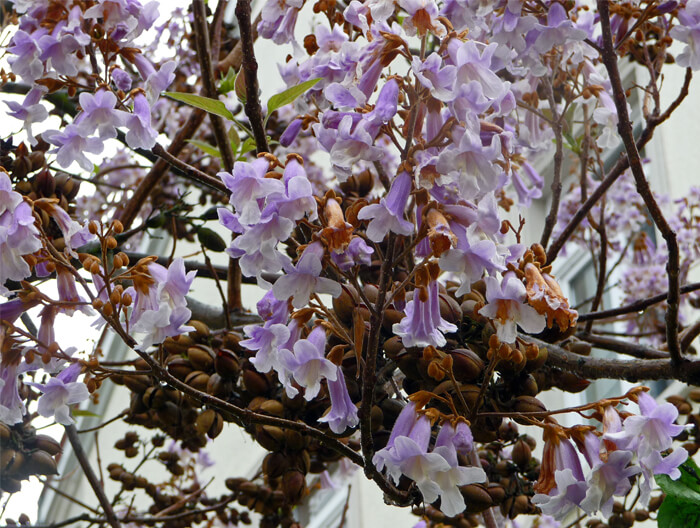 Bunches of flowers blooming in early spring before the new leaves emerge
Source: Commons
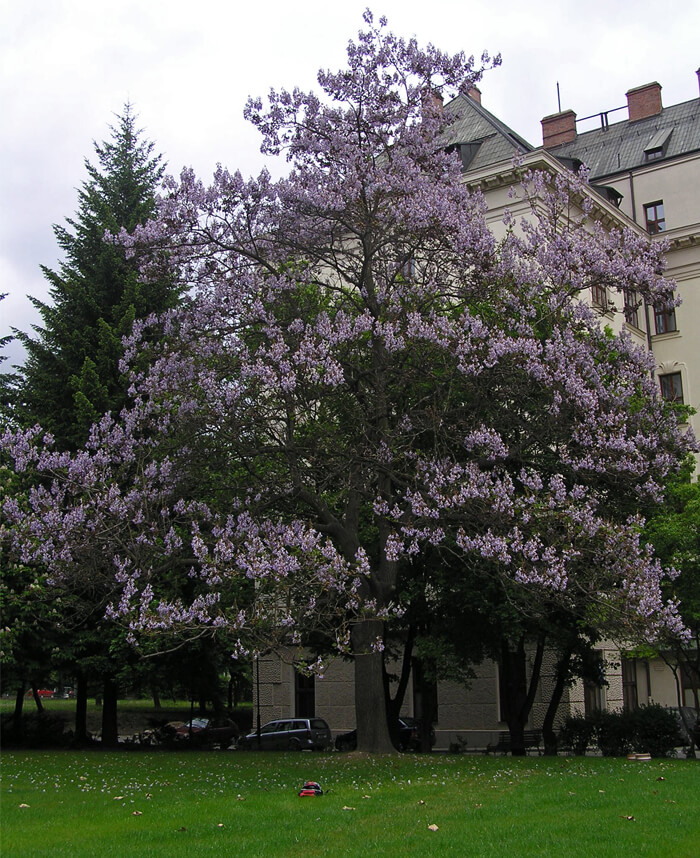 An Empress Tree in full bloom
Source: Commons
 Close up of the large leaves
Source: Commons
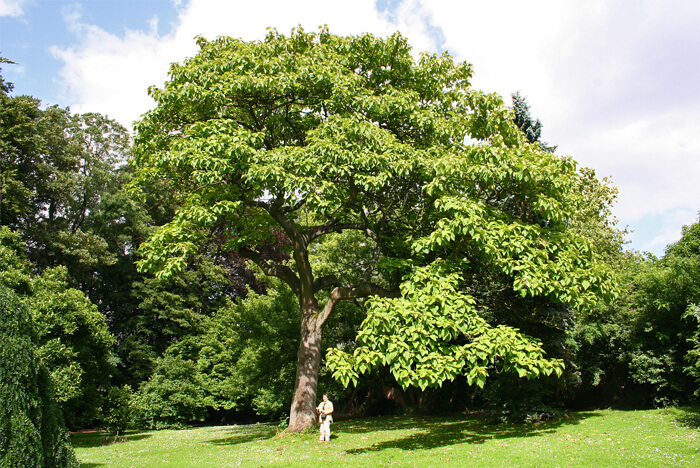 Trees get quite large and need a lot of space
Source: Commons
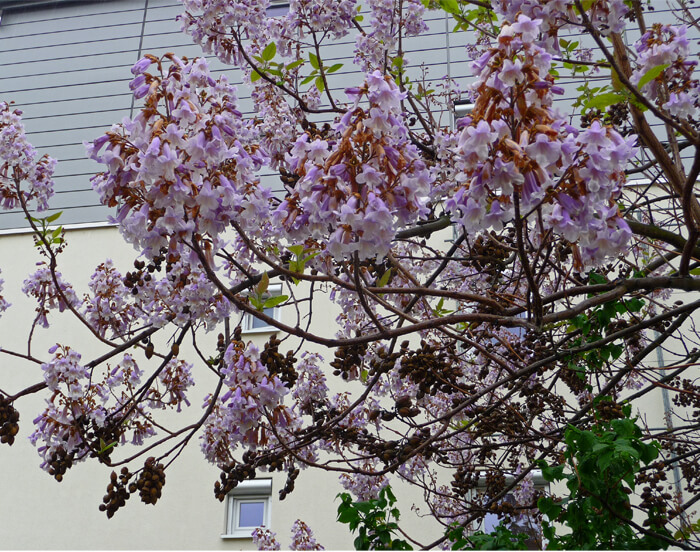 Flowering branches of an Empress Tree
Source: Commons
Packing Plants For ShippingMost of our plants are shipped bare root while they are dormant from late November through April and ship via the U.S. Postal Service. Bamboo plants can be shipped in their containers year-round by UPS.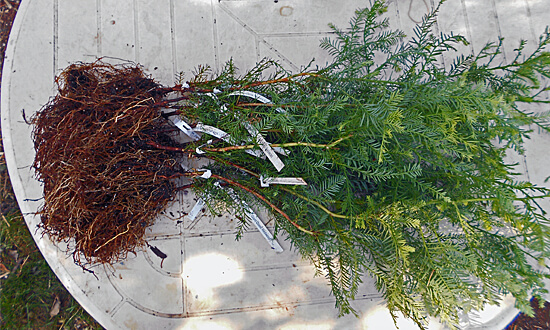 Bare root plants are soaked and wrapped together in bundles. ictured are 10x 24 inch tall Coast Redwoods. 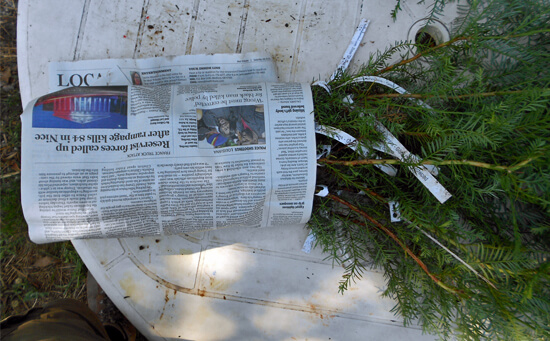 The bundled plants are wrapped in paper and labeled by variety. 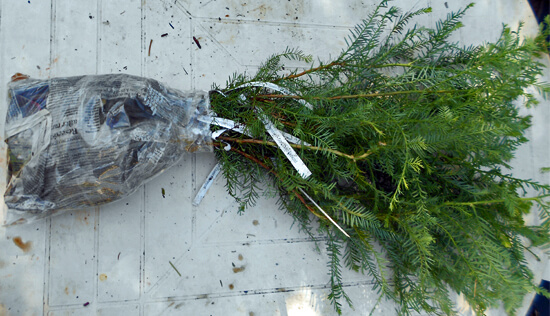 The bundle is wetted and bagged. 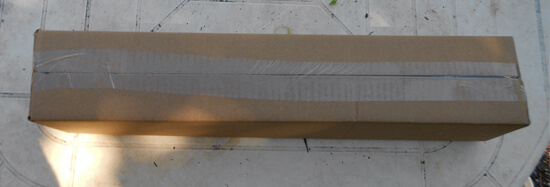 Bundles of plants are secured in long boxes. Pruning and Plant SizesWe prune both the tops and the roots of our plants at least once per year while they are growing in our nursery to ensure they develop a strong, dense form. Regular annual pruning goes a long way to ensure a healthy branching structure and this is often a missed step in many nurseries. Pruning a plant back hard after it has been neglected pruning-wise often results in an irregular branch habit or multiple leaders so we prune early and regularly instead. We also prune the roots of our plants while they are dormant which causes them to produce a much more branched structure and helps to elimate tangled masses that hinder future development. Plants that have been root pruned establish themselves much more quickly than root bound plants. Generally, hardwood plants will be pruned in the winter and conifers will be pruned in the summer.Before shipping plants we prune the tops and roots one last time. Conifers will usually have very little pruning except to balance out long branches. Shrubs are usually pruned to around 1-2 feet tall to encourage low branch development and small to medium sized trees are usually pruned to around 36-40 inches. Pruning trees at this height encourages dominant branches to begin forming around 3 feet from the ground which typically looks the best in most situations. However, if you want a tree to have branching start higher (some city codes require trees to not branch below 4 feet) we have longer boxes available. To request taller trees please contact us at least three days before your ship date. Depending on your location and the shipping routes there may be a fee for oversize package handling (usually about $15 for a 60 inch box). 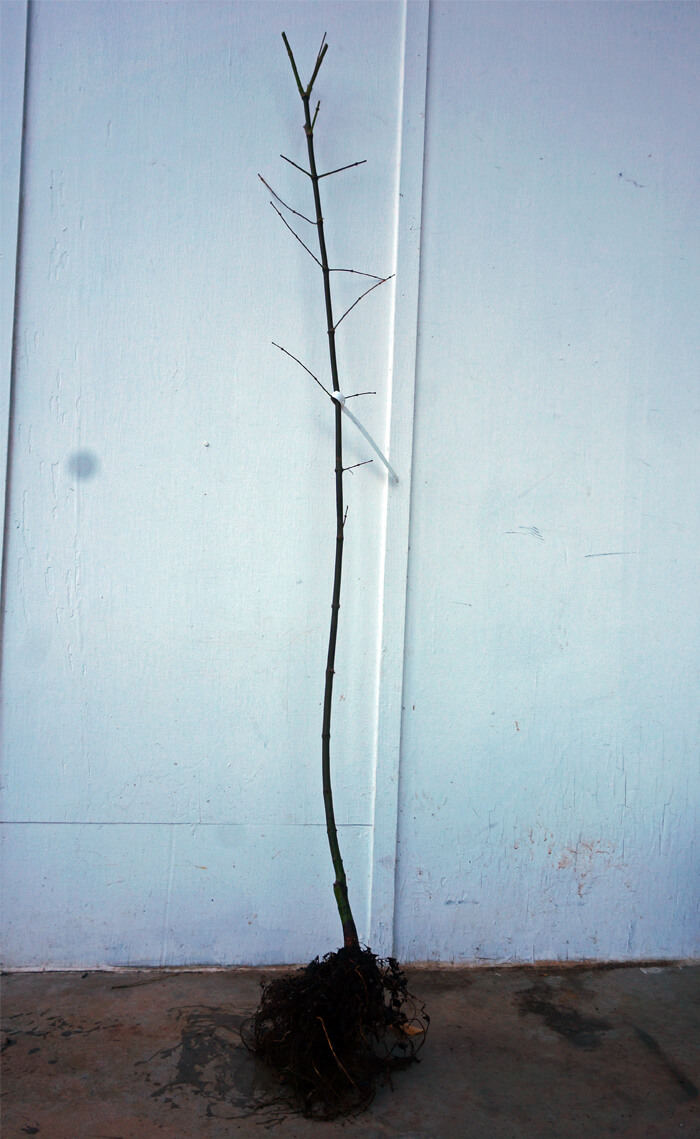 Tall trees (Oaks, Ginkgo, large Maples, etc.) are pruned to 40 inches to encourage crown development from about 36 inches and up 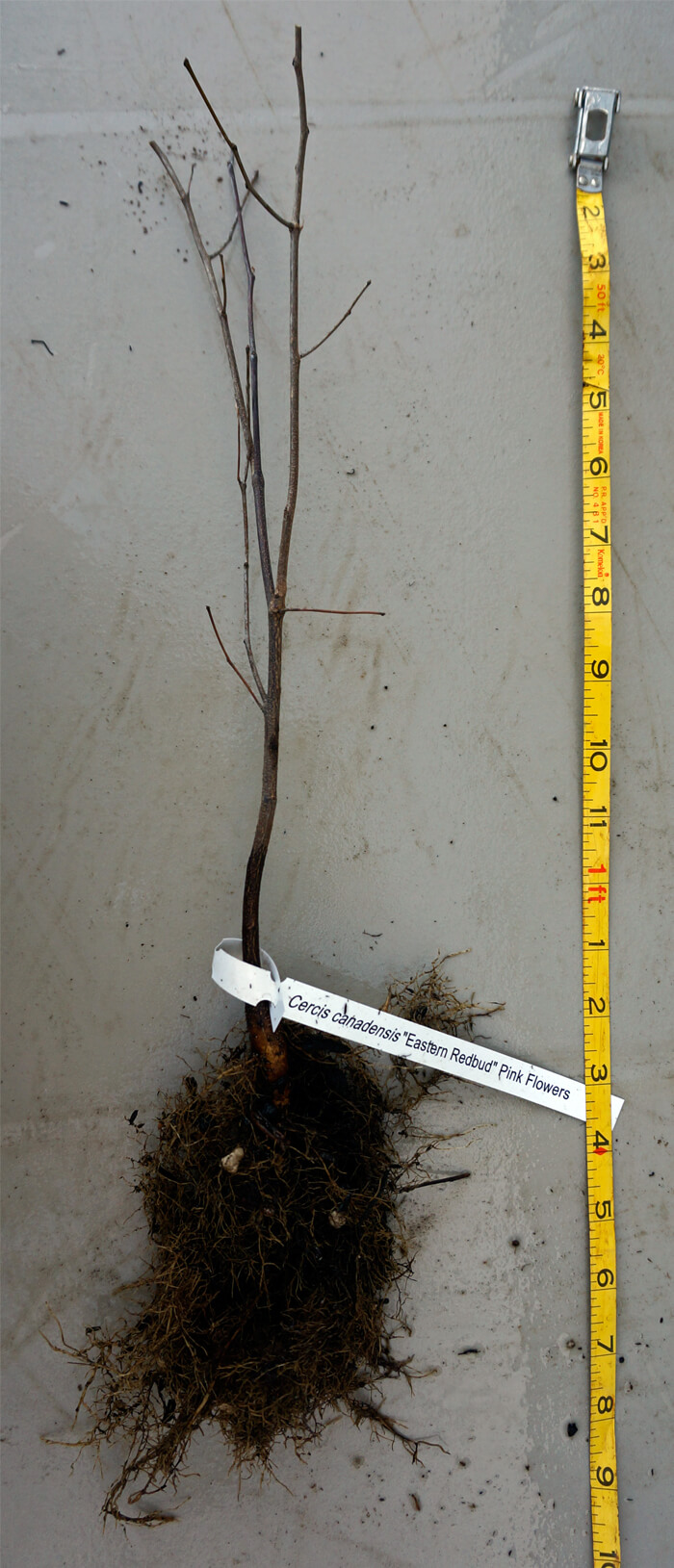 Small and medium trees (short Maples, Redbuds, Stewartia, etc.) are pruned 10-20 inches above the prune line from last year 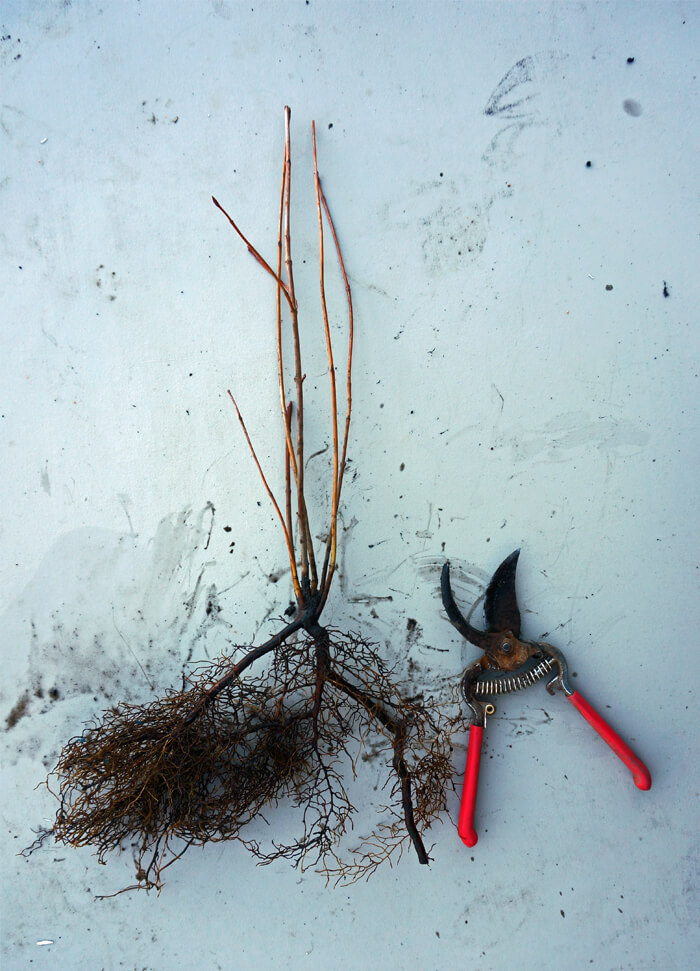 Shrubs (Weigela, Hydrangea, Viburnum, etc.) are pruned to 18 inches tall and root pruned one last time 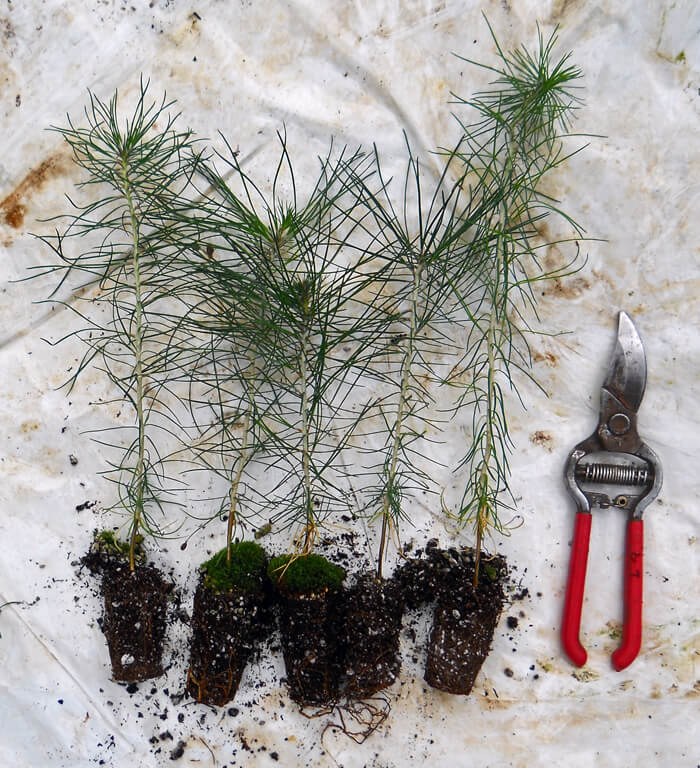 Small plug size Bamboo Plants Are Shipped In Their ContainersBamboo roots are not flexible and so plants have to be shipped in their containers. These plants are heavier and are shipped separately from bare root plants. Because they are potted they can handle longer transit times so can ship via UPS Ground instead of USPS Air Mail. Potted plants can also be shipped year-round.We regularly top our 1 gallon bamboo plants at 24-30 inches tall throughout the growing season. This results in dense, bushy foliage while allowing for economical shipping. From this size most running species will grow to 5-6 feet tall in the first spring and clumping species will usually grow to 4-5 feet tall. 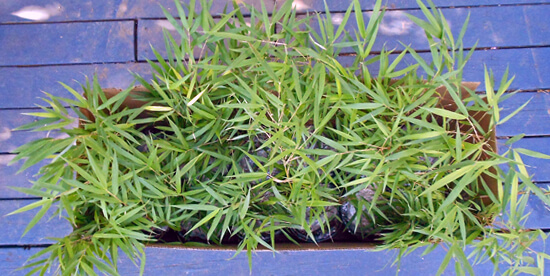 1 gallon bamboo plants strapped in and ready to be sealed. Unpacking Bare Root PlantsYou will be sent tracking details as soon as your plants are shipped. Unpack your plants as quickly as possible after they are delivered. We use two types of boxes, side-sealing and top-sealing. For boxes that are taped along the whole length you can cut the tape on either side and remove the plant bundles by cutting the tape holding the bundle to the bottom. For boxes that are sealed on the top and bottom, it is easiet to open the bottom of the box (the shipping label is at the top) and pull the bundle of plants out straight out. Check that the box is empty as there can be a second bundle of plants stuck towards the top.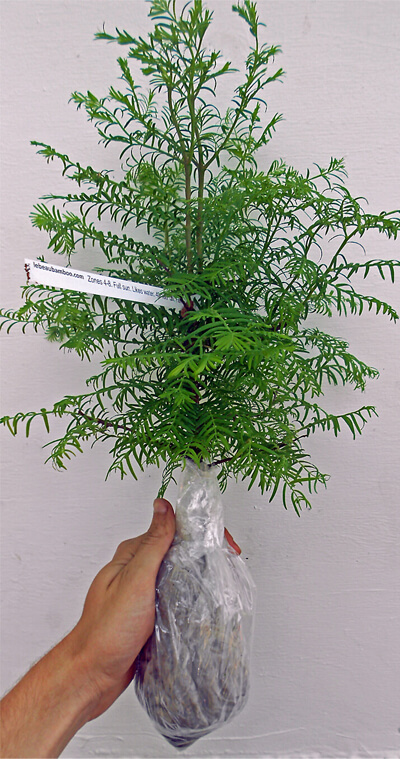 A bundle of trees. What if I am not able to plant right away?You can usually leave the plants in their shipping container unopened for 1-2 days if there were no shipping delays and you have received your plants from late November through February. Plants shipped when it is warmer can't stay in their packages for as long. |
Size Availability
Out of season.
Our main crop of most plants is available starting in late fall.
Additional batches of plugs and quarts are usually added in May.
Many of our plants are propagated in limited quantities and can sell out quickly when posted, get on the notification list below so you don't miss out. Add your email to be notified as soon as we have them back in stock:
This does NOT subscribe your email to any mailing lists, our system will only send an inventory notification message.
|

